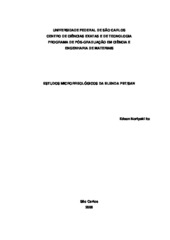| dc.contributor.author | Ito, Edson Noriyuki | |
| dc.date.accessioned | 2016-06-02T19:09:58Z | |
| dc.date.available | 2007-07-10 | |
| dc.date.available | 2016-06-02T19:09:58Z | |
| dc.date.issued | 2006-09-22 | |
| dc.identifier.citation | ITO, Edson Noriyuki. Microrheology of poly(butylene terephthalate) / poly(styrene-co-acrylonitrile) blends.. 2006. 213 f. Tese (Doutorado em Ciências Exatas e da Terra) - Universidade Federal de São Carlos, São Carlos, 2006. | por |
| dc.identifier.uri | https://repositorio.ufscar.br/handle/ufscar/647 | |
| dc.description.abstract | This work was motivated by the need of a better understanding of the
microrheological characteristics of polybutylene terephthalate, PBT, polymer
blends, such as the matrix phase PBT and the styrene-acrylonitrile, SAN
copolymer as dispersed phase. The main purpose of the microrheological
studies carried out was to analyze the rheological behavior and the morphology,
as well as their correlation, in the preparation of the PBT/SAN immiscible blend,
with and without the use of an interfacial compatibilizer. The rheological
behavior was analyzed by torque rheometry, rotational rheometry with parallelplates
geometry, and capillary rheometry. The interfacial tensions were
measured by the modified ellipsoidal drop retraction method, using an optical
polarized light microscope coupled to a hot stage. Two complementary
techniques were used in the morphological analyses: scanning electron
microscopy (SEM) with tetrahydrofuran (THF) extraction of the dispersed
phase, and transmission electron microscopy (TEM) with rutene tetroxide
(RuO4) deposition in the dispersed phase. The interfacial tension between the
PBT polymer and the SAN copolymer was found to increase as the molar mass
of the PBT increased. The use of rotational rheometry with parallel plates at low
shear rates allowed the increase in viscosity to be quantified as a function of the
reaction of the polymeric macromolecules in the PBT/SAN blend compatibilized
or not with the interfacial compatibilizer, the MMA-GMA-EA copolymer. Based
on the morphological characterizations, an analysis was made of the fibril
formation mechanisms, break up and coalescence of the particles of dispersed
phase and their interactions with the addition of interfacial compatibilizers. The
rotational rheometry at low shear rates proved to be extremely efficient in the
analysis of blend compatibilization, which is usually analyzed by torque
rheometry. It was checked that, at high shear rates, the viscosity ratio
influenced the formation of more finely dispersed phases. | eng |
| dc.description.sponsorship | Financiadora de Estudos e Projetos | |
| dc.format | application/pdf | por |
| dc.language | por | por |
| dc.publisher | Universidade Federal de São Carlos | por |
| dc.rights | Acesso Aberto | por |
| dc.subject | Blendas poliméricas | por |
| dc.subject | Microrreologia | por |
| dc.subject | Compatibilização interfacial | por |
| dc.subject | Poli(Tereftalato de butileno) - PBT | por |
| dc.title | Estudos microrreológicos da blenda PBT/SAN. | por |
| dc.title.alternative | Microrheology of poly(butylene terephthalate) / poly(styrene-co-acrylonitrile) blends. | eng |
| dc.type | Tese | por |
| dc.contributor.advisor1 | Hage Júnior, Elias | |
| dc.contributor.advisor1Lattes | http://lattes.cnpq.br/1240692926327687 | por |
| dc.description.resumo | O motivo que levou à realização deste trabalho de doutorado consistiu
na necessidade de um melhor entendimento das características
microrreológicas de blendas poliméricas constituídas de poli(tereftalato de
butileno), PBT, como fase matriz, e do copolímero estireno-acrilonitrila, SAN,
como fase dispersa. Os estudos microrreológicos realizados tiveram como
enfoque principal analisar o comportamento reológico e a morfologia, bem
como suas correlações na preparação da blenda imiscível PBT/SAN, com e
sem a utilização de um compatibilizante interfacial. Nas análises do
comportamento reológico, foram utilizadas reometria de torque, reometria
rotacional na geometria de placas paralelas e reometria capilar. As medidas de
tensões interfaciais foram realizadas através do método de retração de gotas
elipsoidais modificado, utilizando-se de um microscópio óptico com luz
polarizada acoplado a um estágio a quente. Nas análises morfológicas, foram
utilizadas duas técnicas complementares, através de microscopia eletrônica de
varredura (MEV) com extração da fase dispersa com tetrahidrofurano (THF) e
por microscopia eletrônica de transmissão (MET) com a deposição de tetróxido
de rutênio (RuO4) sobre a fase dispersa. Utilizando-se do método de retração
de gota modificado, verificou-se que a tensão interfacial entre o polímero PBT e
o copolímero SAN aumenta com o aumento da massa molar do PBT.
Utilizando-se da reometria de placas paralelas a baixas taxas de cisalhamento,
foi possível quantificar o aumento de viscosidade em função da reação das
macromoléculas poliméricas na blenda PBT/SAN, compatibilizada ou não com
o agente de compatibilização interfacial (o terpolímero metacrilato de metilametacrilato
de glicidila-acrilato de etila, MMA-GMA-EA). Por meio das
caracterizações morfológicas, foi possível analisar os mecanismos de formação
de fibrilas, cominuição e coalescência das partículas de fase dispersa e de
suas interações com a adição de agentes de compatibilização interfacial. A
técnica de reometria rotacional de placas paralelas em baixas taxas de
cisalhamento mostrou-se extremamente eficiente na análise de
compatibilização de blendas, que, na maioria das vezes, é feita através de reometria de torque. Verificou-se que, a altas taxas de cisalhamento, a razão
de viscosidade influencia a formação de fases mais finamente dispersas em
função da taxa de cisalhamento aplicada à blenda PBT/SAN. | por |
| dc.publisher.country | BR | por |
| dc.publisher.initials | UFSCar | por |
| dc.publisher.program | Programa de Pós-Graduação em Ciência e Engenharia de Materiais - PPGCEM | por |
| dc.subject.cnpq | ENGENHARIAS::ENGENHARIA DE MATERIAIS E METALURGICA | por |
| dc.contributor.authorlattes | http://lattes.cnpq.br/7249500407405478 | por |
